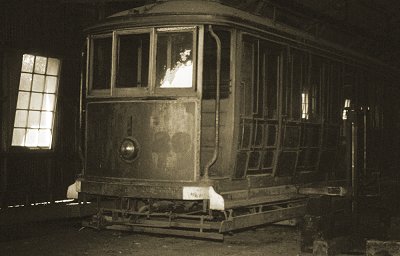Melbourne Tram Museum
- Follow Melbourne Tram Museum on Twitter
- Follow Melbourne Tram Museum on Facebook
- Follow Melbourne Tram Museum on Instagram
- Follow Melbourne Tram Museum on Pinterest
- Follow Melbourne Tram Museum on Tumblr
- Subscribe to Melbourne Tram Museum's RSS feed
- Email Melbourne Tram Museum
Victorian Railways No 20
VR 20 is historically significant as it is the only surviving single-truck tramcar of Victorian Railways. Although the tram design was in the end unsuccessful as a passenger-carrying vehicle, it is also important as a lesson on the necessity for vehicle design to consider such things as clothing fashions and employees’ occupational health and safety concerns.
This tramcar was the first of an order of eight built in 1913 for Victorian Railways (VR) by Pengelley and Company of Edwardstown, South Australia, for use on the broad gauge St Kilda to Brighton Beach tramway. The design was modelled on a prototype tramcar built by VR Newport Workshops in 1912, which itself was based on the Sydney J class design of 1904.
 VR No 20 in Elwood Depot, January 1959.
VR No 20 in Elwood Depot, January 1959.- Photograph courtesy of Bob Merchant.
It entered service during May 1913, but these cars were decidedly unpopular with the public. The floor of the tramcar was high above the roadway, so there were two stepped running boards to allow passengers to clamber up into the tram. While this may have been marginally acceptable for men, the introduction of these tramcars coincided with the popularity of the ‘hobble’ skirt in women’s fashion. These skirts severely restricted the length of women’s stride. This by-product of fashion required women to lift the skirts to almost knee level to board this particular type of tramcar, exposing their lower limbs (even the word ‘leg’ was not used in polite company), offending public morals and causing general outrage.
Additionally, the lack of an aisle through the seating meant that in order to collect fares, the conductor had to swing along the outside running boards, opening and closing the sliding doors as he (female conductors were never used on trams such as VR20 that did not have aisles) collected fares. This meant that the conductor was exposed to the dangers of being struck by passing motor vehicles, or falling from the tramcar while it was in motion. This was particularly dangerous when the running boards were slippery from wet weather – not to mention the mud from the unmade roads that was tracked onto the tram on the soles of passengers’ shoes and boots.
VR was pressured to replace these tramcars, and as a result introduced bogie drop-centre tramcars with much reduced step heights between 1917 and 1923. Six of the unsatisfactory cross-bench cars were converted to standard gauge and transferred to the new Sandringham to Black Rock tramway in 1919, but No 20 remained at Elwood Depot to run on the Brighton line, along with the prototype car No 19.
This car was fitted with airbrakes in 1924, but it was withdrawn from passenger service in 1929. It was stripped of all seating and the internal partitions removed, and used as a breakdown car, carrying re-railing and other equipment to assist trams to return to the depot when they failed in traffic. In this form it remained in service to the closure of the Brighton tramway in 1959.
It was purchased by prominent tramway enthusiast Bob Prentice and lived in his Prahran backyard until his death in 1992. It was left at his bequest to the Victorian State Government. It is owned by VicTrack on behalf of the Government and people of Victoria.
This historic tramcar, the last surviving single truck car of the Victorian Railways, is now part of the collection of the Melbourne Tram Museum. However, it is currently in an unrestored condition and is stored in a secure location offsite.
Technical details
| Motors: | 2 x 40hp (GE 80A) |
| Controller: | GE B18 |
| Truck: | Brill 21E |
| Passengers: | 50 (seated) |
| Weight: | not available |
| Length: | 29 feet 4 inches |
| Width: | 7 feet 4 inches |
Bibliography
Cross, N., Budd, D., and Wilson, R. (1993) Destination City (Fifth Edition), Transit Australia Publishing
Harrigan, L. J. (1962) Victorian Railways to ’62, Victorian Railways
Marshall-Wood, L. (1966) The Brighton Electric Line, Traction Publications